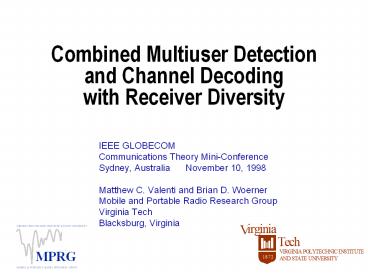Combined Multiuser Detection and Channel Decoding with Receiver Diversity - PowerPoint PPT Presentation
Title:
Combined Multiuser Detection and Channel Decoding with Receiver Diversity
Description:
Resolvable interference comes from within the same cell. ... Eb/No = 20 dB. For conventional receiver, performance is worse as C/I gets smaller. ... – PowerPoint PPT presentation
Number of Views:35
Avg rating:3.0/5.0
Title: Combined Multiuser Detection and Channel Decoding with Receiver Diversity
1
Combined Multiuser Detection and Channel
Decodingwith Receiver Diversity
- IEEE GLOBECOM
- Communications Theory Mini-Conference
- Sydney, Australia November 10, 1998
- Matthew C. Valenti and Brian D. Woerner
- Mobile and Portable Radio Research Group
- Virginia Tech
- Blacksburg, Virginia
2
Outline of Talk
- Multiuser detection for TDMA systems.
- Macrodiversity combining for TDMA.
- Turbo-MUD for convolutionally coded asynchronous
multiple-access systems. - Proposed System.
- The Log-MAP algorithm.
- For decoding convolutional codes.
- For performing MUD.
- Simulation results for fading channels.
3
Multiuser Detection for the TDMA Uplink
- For CDMA systems
- Resolvable interference comes from within the
same cell. - Each cochannel user has a distinct spreading
code. - Large number of (weak) cochannel interferers.
- For TDMA systems
- Cochannel interference comes from other cells.
- Cochannel users do not have distinct spreading
codes. - Small number of (strong) cochannel interferers.
- MUD can still improve performance for TDMA.
- Signals cannot be separated based on spreading
codes. - Delay, phase, and signal power can be used.
4
Macrodiversity Combining for the TDMA Uplink
- In TDMA systems, the cochannel interference comes
from adjacent cells. - Interferers to one BS are desired signals to
another BS. - Performance could be improved if the base
stations were allowed to share information. - If the outputs of the multiuser detectors are
log-likelihood ratios, then adding the outputs
improves performance.
BS 1
MS 1
BS 3
MS 3
MS 2
BS 2
5
Macrodiversity Combiner
- Each of M base stations has a multiuser detector.
- Each MUD produces a log-likelihood ratio of the
code bits. - The LLRs are added together prior to the final
decision.
Multiuser Estimator 1
Multiuser Estimator M
6
Turbo Multiuser Detection
- Most TDMA systems use forward error correction
(FEC) coding. - The process of multiuser detection and FEC can be
combined using iterative processing. - Turbo-MUD
- This is analogous to the decoding of serially
concatenated turbo codes, where - The outer code is the convolutional code.
- The inner code is an MAI channel.
- The MAI channel can be thought of as a time
varying convolutional code with complex-valued
coefficients.
7
Turbo MUD System Diagram
multiuser interleaver
Convolutional Encoder 1
interleaver 1
MAI Channel
MUX
n(t) AWGN
Convolutional Encoder K
interleaver K
Turbo MUD
multiuser interleaver
APP
Bank of K SISO Decoders
SISO MUD
multiuser deinterleaver
Estimated Data
8
Macrodiversity Combining for Coded TDMA Systems
- Each base station has a multiuser estimator.
- Sum the LLR outputs of each MUD.
- Pass through a bank of Log-MAP channel decoder.
- Feed back LLR outputs of the decoders.
9
The Log-MAP Algorithm
- The Viterbi Algorithm can be used to implement
- The MUD (Verdu, 1984).
- The convolutional decoder.
- However, the outputs are hard.
- The iterative processor requires soft outputs.
- In the form of a log-likelihood ratio (LLR).
- The symbol-by-symbol MAP algorithm can be used.
- Bahl, Cocke, Jelinek, Raviv, 1974. (BCJR
Algorithm) - The Log-MAP algorithm is performed in the Log
domain, - Robertson, Hoeher, Villebrun, 1997.
- More stable, less complex than BCJR Algorithm.
- We use Log-MAP for both MUD and FEC.
10
MAI Channel Model
- Received signal at base station m
- Where
- a is the signature waveform of all users.
- Assumed to be a rectangular pulse.
- ?k,m is a random delay of user k at receiver m.
- Pk,mi is power at receiver m of user ks ith
bit. - Matched filter output for user k at base station
m
11
Log-MAP MUD AlgorithmSetup
- Place y and b into vectors
- Place the fading amplitudes into a vector
- Compute cross-correlation matrix for each BS
- Assuming rectangular pulse shaping.
12
Log-MAP MUD AlgorithmExecution
S3
S2
S1
S0
i 0
i 6
i 3
i 2
i 1
i 4
i 5
Jacobian Logarithm
Branch Metric
13
Simulation Parameters
- The uplink of a TDMA system was simulated.
- 120 degree sectorized antennas.
- 3 cochannel interferers in the first tier.
- K3 users.
- M3 base stations.
- Fully-interleaved Rayleigh flat-fading.
- Perfect channel estimation assumed.
- Each user is convolutionally encoded.
- Constraint Length W 3.
- Rate r 1/2.
- Block size L4,096 bits
- 64 by 64 bit block interleaver
14
Performance for Constant C/I 7dB
15
Performance for Constant Eb/No 6dB
16
Conclusion and Future Work
- MUD can improve the performance of TDMA system.
- Performance can be further improved by
- Combining the outputs of the base stations.
- Performing iterative error correction and
multiuser detection. - This requires that the output of both the MUDs
and FEC-decoders be in the form of log-likelihood
ratios. - Log-MAP algorithm used for both MUD and FEC.
- The study assumes perfect channel estimates.
- The effect of channel estimation should be
considered. - Decision directed estimation should be possible.
- Output of each base station can assist estimation
at the others.
17
Uncoded Performance for Constant C/I
- C/I 7 dB
- Performance improves with MUD at one base
station. - An additional performance improvement obtained by
combining the outputs of the three base stations.
18
Uncoded Performance for Constant Eb/No
- Performance as a function of C/I.
- Eb/No 20 dB.
- For conventional receiver, performance is worse
as C/I gets smaller. - Performance of single-base station MUD is
invariant to C/I. - Near-far resistant.
- For macrodiversity combining, performance
improves as C/I gets smaller.






























